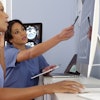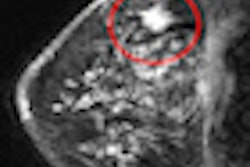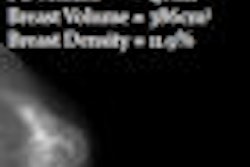A new Connecticut law that mandates that women undergoing mammography be informed of their breast tissue density rating could spark increased use of ultrasound for breast cancer screening. But are radiologists ready for the additional workload if similar legislation spreads across the U.S.?
Proponents say the Connecticut law, enacted in October 2009, is an important first step toward educating the general population regarding the connection between breast density and cancer risk -- and in making better screening tools such as ultrasound available for women with higher breast density.
But opponents say that the law was enacted based on political considerations rather than science, and ultrasound's role as a screening modality is still unproven. Even some who favor breast ultrasound screening believe that the time involved in performing breast ultrasound studies in a high-throughput environment means that mammography sites will have to be prepared for the additional workload -- and few are.
Higher risk
The link between breast density and breast cancer risk has been demonstrated in multiple clinical studies. Women with breast density of at least 75% have a four to five times higher risk of breast cancer than women with little or no density, according a study presented this month at the American Association for Cancer Research (AACR) meeting.
And data published in the Journal of the American Medical Association in 2008 from the American College of Radiology Imaging Network (ACRIN) 6666 trial showed that not only do more than half of women younger than 50 have dense breast tissue (as do one-third of women older than 50), mammography's sensitivity for women with dense breast tissue can be as low as 30% to 48%, with higher interval cancer rates and worse prognosis for the resulting clinically detected cancers. The authors of the study said that adding ultrasound boosted sensitivity to 77.5% in these women, and they suggested that ultrasound could be offered as a supplemental screening tool.
“Screening ultrasound is about to come into the mainstream ... and radiology is not prepared.”
— Jerry Kolb, Solis Women's
Health, Addison, TX
Although clinicians have been aware of the relationship between breast tissue density and increased cancer risk for years, it's only until recently that patients with elevated density were told of their higher risk at screening, according to Jerry Kolb, chief knowledge officer of Solis Women's Health, a network of individual breast diagnostic centers based in Addison, TX.
That's beginning to change, with more women demanding to know their breast density and whether they need access to additional imaging. As a result, radiologists even in states without laws like what's on the books in Connecticut will be pressed to step up, both in communicating breast tissue density results to patients and in performing more ultrasounds, Kolb said.
"Women are finding out that radiologists knew more than a decade ago that mammography wasn't enough as a screening tool for dense breast tissue, and they're pretty mad," he said. "If I were a radiologist, I'd start quaking now. There's no fury like patients demanding tests they believe they're owed."
Connecticut blazes the trail
The Connecticut statute requires patient breast density status to be disclosed in mammography reports. The legislation was prompted in part by the experience of Nancy Cappello, Ph.D., a Connecticut woman who received an advanced-stage breast cancer diagnosis in 2004 at age 51. Because Cappello had dense breast tissue, her cancer was not discovered by annual mammograms, even though she had already received more than 10.
After undergoing treatment for stage III breast cancer, Cappello founded Are You Dense?, an organization that urges women to be informed about dense breast tissue and how it affects early detection of breast cancer.
"In 2004, I did research during my treatment, trying to find out information about dense tissue, and discovered that six studies had been done [on the issue], involving more than 38,000 women," Cappello told AuntMinnie.com. "Information about my health was being kept from me. I went to my breast surgeon and asked why doctors don't tell women about breast density and was told, 'It's not standard protocol.' Well, you know what? I had advanced cancer, and that was not a good enough response."
The Connecticut law requires that all written results of a mammogram given to a patient include information about breast density based on the American College of Radiology's Breast Imaging Reporting and Data System (BIRADS). When applicable, the report must include the following notice: "Your mammogram demonstrates that you have dense breast tissue, which could hide small abnormalities, and you might benefit from supplementary screening tests, which can include a breast ultrasound screening or a breast MRI examination, or both, depending on your individual risk factors. A report of your mammography results, which contains information about your breast density, has been sent to your physician's office and you should contact your physician if you have any questions or concerns about this report."
An earlier version of the bill was introduced in 2008, but it did not receive support at that time from the Radiological Society of Connecticut, according to Dr. Alan Kaye, chair of the Society's legislative committee and chair of radiology at Bridgeport Hospital in Bridgeport. It was only after ACRIN 6666 trial results came out that the Society supported the bill.
"When [the bill] came up earlier, [the Society was] opposed," Kaye told AuntMinnie.com. "At the time there was no science supporting the link between breast density and the use of ultrasound. But we knew there was an ongoing ACRIN trial. So despite significant support in the Connecticut legislature we convinced them that the science didn't justify [the bill] and that we might be subjecting people to unnecessary studies. When the ACRIN results came out, I wouldn't say that they 100% clearly showed that dense breasts were risk factor, or that ultrasound was necessary, but the data were credible and were noticed by the key legislators. Since we had pinned our [response] to [the ACRIN results] the year before, we supported the bill."
How has the new law affected clinical practice? After an initial flurry of confusion, things have settled down, according to Carol Schweitzer-Schilling, a radiologic technologist and outpatient center coordinator for radiology at Middlesex Hospital in Middletown, CT.
"There was a lot of confusion at first as to what the exact requirements of the law were," she said. "We changed our patient letter [to comply with the law], and we have seen an uptick in breast ultrasound, an increase of about 150 more exams when we compare numbers from October 2008 to March 2009 and numbers from October 2009 to March 2010. And we're still learning about how to coordinate the screening mammogram and the screening ultrasound, depending on the woman's menstrual cycle and the exam results."
Cutting edge, or costly and cumbersome?
But some question the science behind Connecticut's actions and warn that if more states follow suit, there will be a spike in healthcare costs.
"The Connecticut law is a major problem: It is not based on science, but [rather] the anecdotal belief that dense breast tissues are a major risk for breast cancer and the fact that there are some cancers that can be detected by ultrasound that are not detected by mammography," Dr. Daniel Kopans, professor of radiology at Harvard Medical School in Boston, told AuntMinnie.com in an e-mail. "The ... law will lead to a major increase in healthcare costs, unproven ultrasound screening, and unnecessary ultrasound-engendered biopsies without any proof of benefit for women. It should be rescinded."
There are also other issues that make screening ultrasound tricky. The amount of time required to perform bilateral screening ultrasound is problematic, according to the ACRIN research. The procedure is lengthy, with a median of 19 minutes per exam, not including comparison of prior studies, discussion of results with patients, or the creation of final reports.
In addition, there is one Medicare billing code for breast ultrasound -- 76645 -- that covers general use, not screening. Current global reimbursement for the code is $89, an amount that does not fully cover the costs of performing and interpreting the exam.
Automated, whole-breast ultrasound may increase the use and profitability of screening ultrasound, but it will also result in hundreds more images for interpretation, which, in turn, leads to a need for more physicians and technologists, as well as increased malpractice exposure.
The Connecticut law, combined with the ACRIN 6666 trial findings and women's increased awareness about breast density and cancer risk, may mean that ultrasound has hit a tipping point in its use and acceptance as a screening tool for high-risk women, according to Kolb. And, in fact, another breast cancer survivor, Henda Salmeron of DenseBreastTissue in Dallas, is working to garner support to pass legislation similar to the Connecticut law across the U.S.
"Screening ultrasound is about to come into the mainstream," Kolb said. "With one state in the country having adopted this, there will be a steamroller effect that drives its use. And radiology is not prepared. If 35% of the population is over 50% dense, and radiologists will therefore be increasing their use of ultrasound by 35%, there will be [at least] manpower issues."
By Kate Madden Yee
AuntMinnie.com staff writer
April 29, 2010
Related Reading
Inexperienced readers benefit most from breast US CAD, March 5, 2010
Mātakina tackles breast density problem with Volpara software, February 3, 2010
Color Doppler US predicts survival of breast cancer patients, January 26, 2010
Road to RSNA, Ultrasound, ABUS plus DBT improves specificity of diagnosis, November 11, 2009
Fuzzy 3D ultrasound CAD sharpens breast cancer sensitivity, September 3, 2009
Copyright © 2010 AuntMinnie.com




















